
Price: $2,699
Screen size: 65 inches
Model: QN65QN90DAF
Resolution: 3,840x2,160
HDR: HDR10, HDR10+, HLG
Refresh Rate: 144Hz
Ports: 4 HDMI 2.1, 2 USB
Audio: 60W
Smart TV Software: Tizen
Size (without stand): 56.9x32.6x1.1 inches
Weight (without stand): 53.4 pounds
Samsung is probably the first name that comes to mind when you think of QLED TVs, and its latest addition to the lineup is only going to add to its clout: The Samsung QN90D Neo QLED TV unites quantum dots and Mini LEDs to deliver an attractive picture alongside an enticing collection of features.
Missteps here are few. Picture-wise, its color accuracy is a little low, and a few elements — like its lack of an ATSC 3.0 tuner — make this TV feel a bit behind the times. That said, the QN90D is a significant improvement over last generation’s QN90C, and is one of the best TVs of 2024 despite some shortcomings.
So why doesn’t it earn a 4.5-star rating or higher? It’s primarily the QN90D’s exorbitant price that keeps it from outshining the Hisense U8N or LG C4 OLED,though we expect that price will drop precipitously as we approach major sales holidays like Black Friday and Cyber Monday. For now, however, if you don’t mind paying a premium for a QLED TV that checks almost all the right boxes, the QN90D is one of the best 4K TVs you can buy.
Samsung QN90D Neo QLED TV review: Pricing and availability
We evaluated the 65-inch version of the Samsung QN90D, but it comes in seven different sizes to fit every living room and budget. These are:
- Samsung QN43QN90DAF (43-inch): $1,499.99 | Sale: $1,399.99
- Samsung QN50QN90DAF (50-inch): $1,599.99 | Sale: $1,499.99
- Samsung QN55QN90DAF (55-inch): $1,999.99 | Sale: $1,799.99
- Samsung QN65QN90DAF (65-inch): $2,699.99 | Sale: $2,499.99
- Samsung QN75QN90DAF (75-inch): $3,299.99 | Sale $2,999.99
- Samsung QN85QN90DAF (85-inch): $4,799.99 | Sale $4,499.99
- Samsung QN98QN90DAF (98-inch): $14,999.99 | Sale $12,999.99
The 55- through 85-inch models have nearly identical hardware, so we expect the picture to be comparable across those four sizes. The others have a few differences. The 43- and 50-inch versions use a different HDR engine, so you may expect some divergence in terms of picture quality; they also use lower-powered speaker systems (20W and 40W respectively) and Object Tracking Sound Lite for their audio. The 98-inch size maxes out the line’s features, with one exception: Its four HDMI ports top out at refresh rates of 120Hz — not 144Hz.
Samsung QN90D Neo QLED TV review: Design
The QN90D has a no-nonsense design with sensible dimensions (56.9x32.6x1.1 inches) and a weight (53.4 pounds) heavy enough that you will likely need some help unboxing and setting up the set.
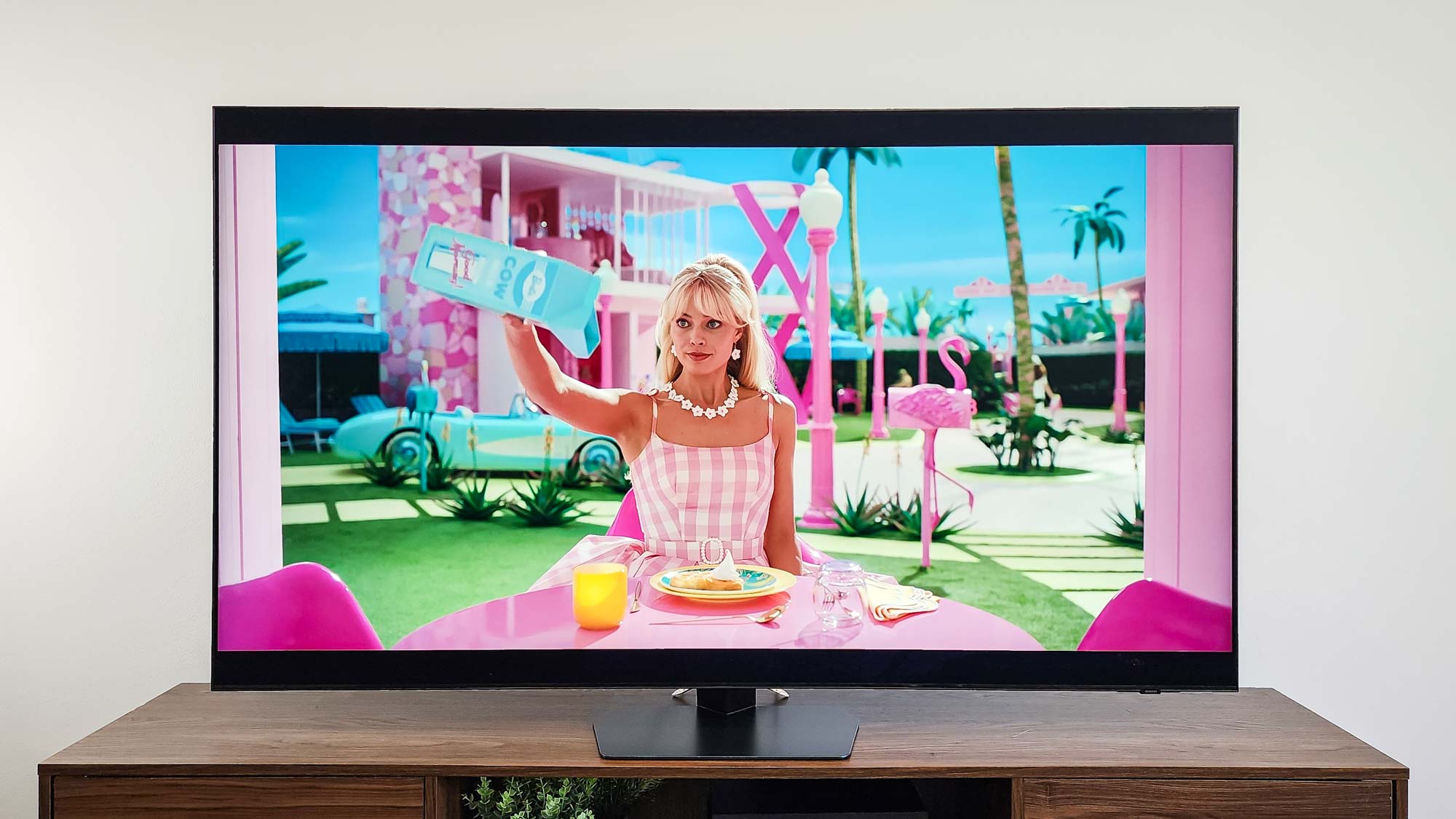
A thin (one-eighth inch), dark-gray metal bezel graces the left, right, and top of the screen, and there’s a slightly wider one (one-third inch) on the bottom. The only other visible adornment on the front is a small black tag containing Samsung’s logo, which also obscures hardware controls that let you turn the TV on and off, change the channel, adjust the volume and choose a source without needing the remote control.
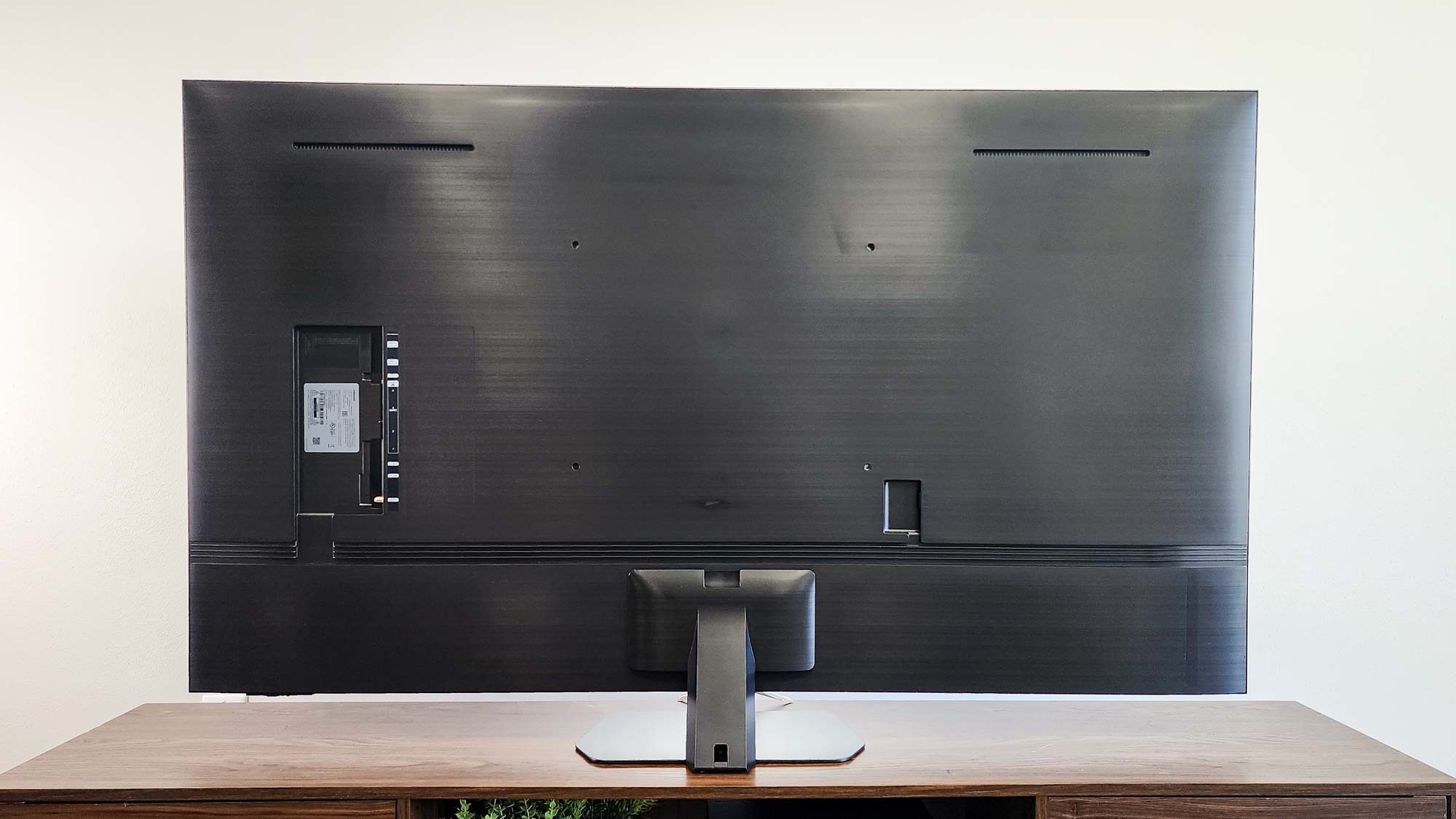
Should you want to mount the TV on the wall, 400x300mm VESA holes on the rear panel exist for just that purpose. If wall-mounting isn’t an option or not something you’re interested in you may use the included stand.
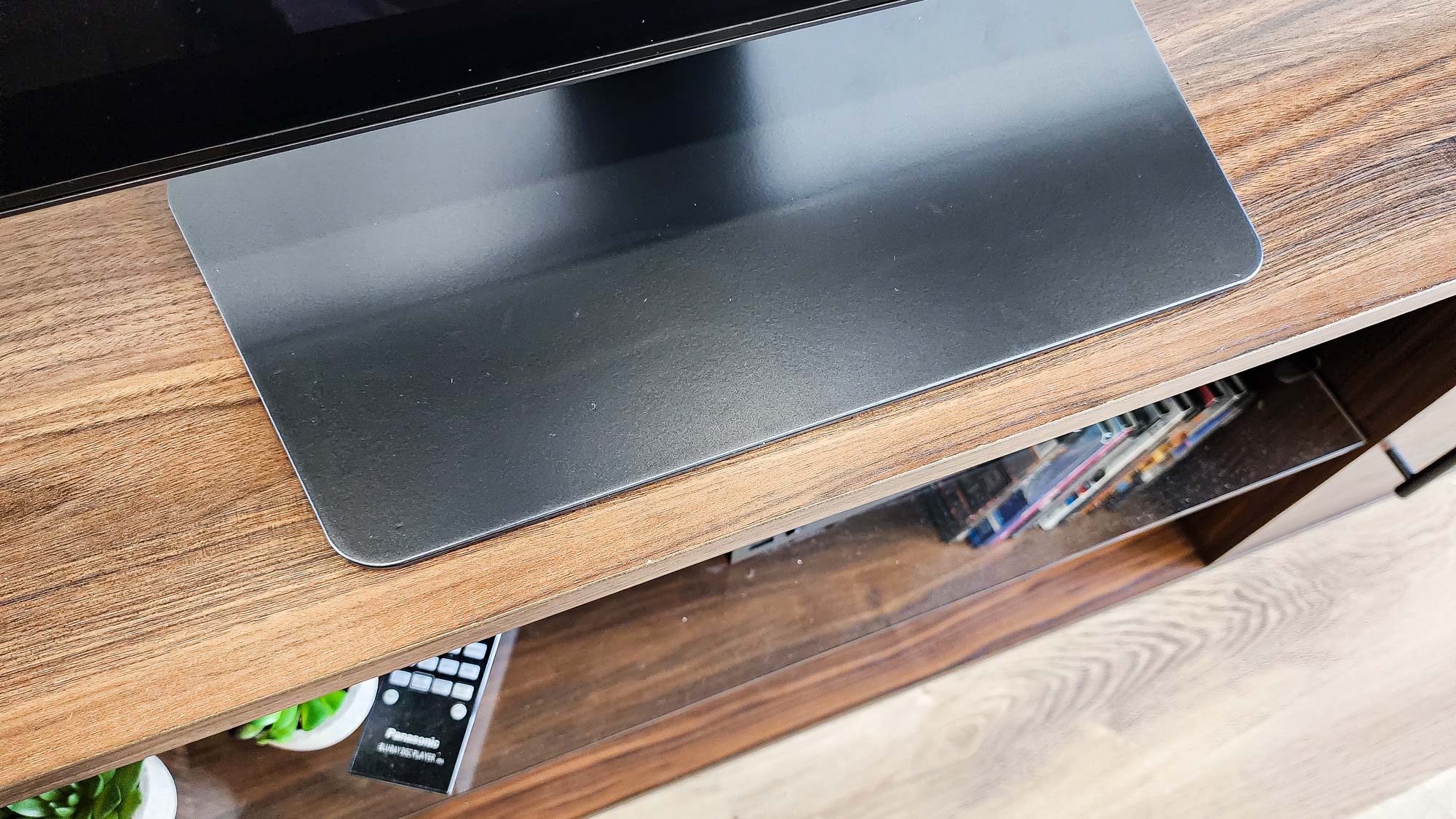

It’s an easy-to-assemble, multipiece stand with a metal foot in the front and a thick plastic leg in the back; just screw the parts together, then screw them onto the TV. A channel in the leg simplifies the process of routing cables, and there’s a plastic cover for the leg that will give things a tidier look still.
Samsung QN90D Neo QLED TV review: Ports
The power cable extends straight outwards from the rear panel near the QN90D’s left edge, and all the other ports are conveniently angled out the TV’s right edge. These include two USB; S/PDIF optical audio out; Ethernet; Ex-Link; coaxial cable; and four HDMI ports, all of which bear the newer and more powerful HDMI 2.1 standard.

HDMI 2.1 confers a range of next-generation features including Variable Refresh Rate (VRR) and Auto Low-Latency Mode (ALLM). Even more interesting here is that all four ports support not just 4K at 120Hz, which is an HDMI 2.1 staple, but 4K at 144Hz when you connect a PC with a compatible graphics card. It’s not uncommon to find one or two ports that can do this on a TV, but it’s nice that Samsung removes all limits for what and how you can connect to the QN90D.
Samsung QN90D Neo QLED TV review: How We Test
We follow a standard testing protocol for every TV we review at Tom’s Guide. Our benchmarks include a series of technical and subject tests designed to rate the set’s performance. For our technical tests, we use an X-Rite i1 Pro spectrophotometer, a SpectraCal VideoForge Pro pattern generator, and Portrait Displays’ Calman TV-calibration software to take measurements. We also use a Leo Bodnar 4K Input Lag Tester for determining the TV’s gaming prowess.
Subjective tests vary based on the reviewer, but usually feature anecdotes from a diverse selection of movies, TV shows, and other content reflecting the types of things you may actually want to watch on the TV. For a more detailed look at what we do and how we do it, check out our “How we test TVs” page.
Samsung QN90D Neo QLED TV review: Performance
The QN90D delivered eye-popping visual fidelity in my testing, and that’s thanks to Samsung’s combination of quantum dots and Mini LEDs, plus its array of AI-driven picture technologies intended to enhance everything from depth perception to upscaling and HDR remastering.
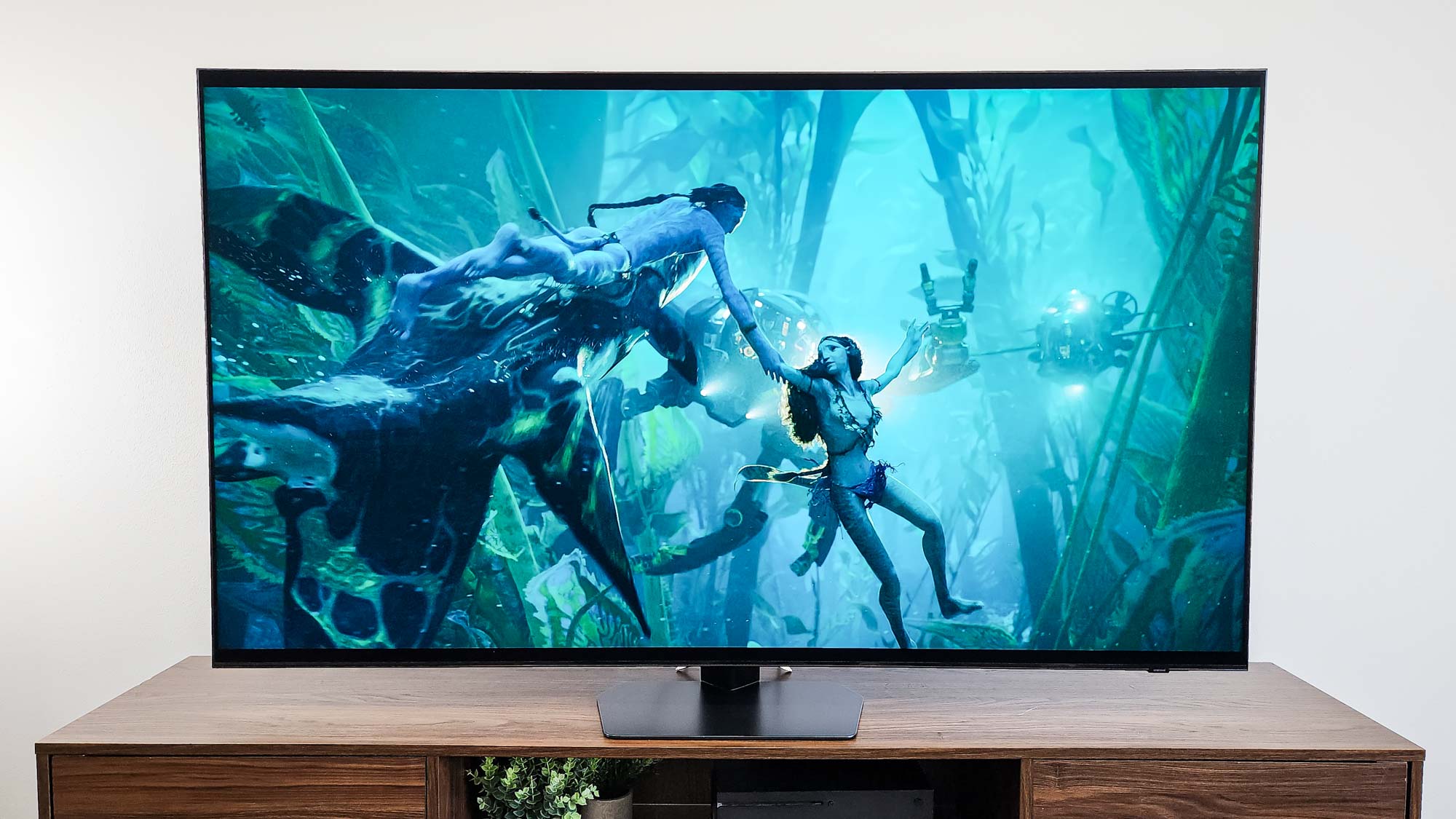
Titles like Avatar: The Way of Water, Barbie, and The Super Mario Bros. Movie, which thrive on especially vibrant colors, burst off the screen with a wave of dazzling brightness behind them. More action-oriented offerings, such as Netflix’s 3 Body Problem, Mission: Impossible—Dead Reckoning, and Spider-Man: Across the Spider-Verse, thrill with their luxuriously smooth fast motion.
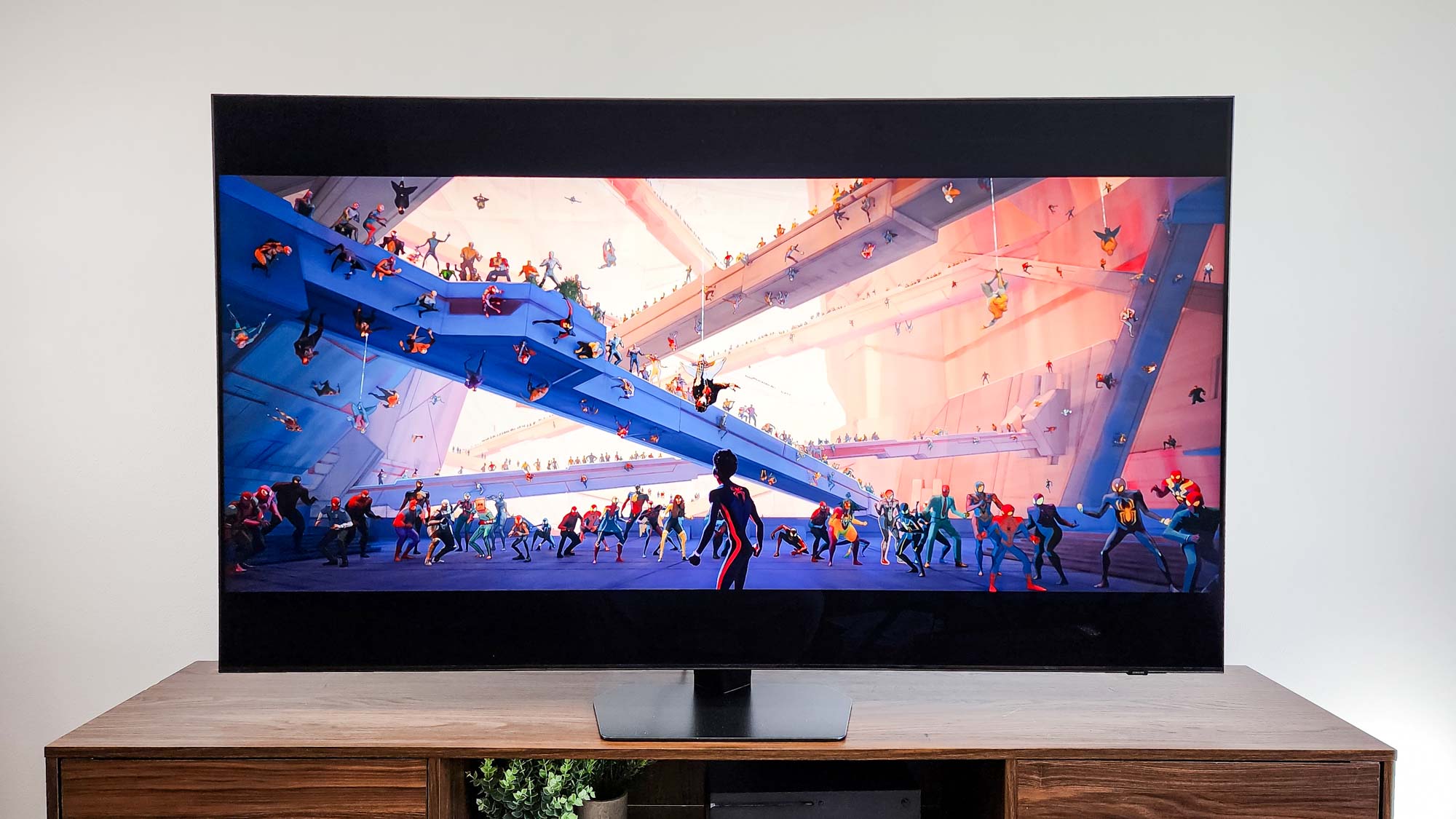
You can easily see the benefits of the QN90D’s superior contrast in movies like Denis Villeneuve’s Dune and Christopher Nolan’s Oppenheimer, where blazing and shadowy scenes alike are produced with equal fidelity and only faint traces of light bloom discernible (and then only rarely). The QN90D handles HDR10, HDR10, and HLG content deftly, but, like other Samsung sets, it does not support Dolby Vision.

This TV doesn’t quite reach OLED levels of black perfection — few Mini-LED TVs do — but it comes closer than most. Upscaled 1080p video has near-native-4K detail in most cases. And no matter what you’re watching, it looks good from even relatively extreme angles — no small feat for a non-OLED screen.
Samsung QN90D Neo QLED TV review: Test Results
Although the QN90D’s SDR brightness of 248 nits may not sound impressive on the face of it, it’s important to remember that that’s measured using Filmmaker Mode, the picture setting intended to replicate movie directors’ intentions as much as possible. Standard mode leans significantly brighter (2,043 nits), and our tests showed that, with HDR content, the QN90D could get up to 2,091 nits in Filmmaker — a dazzling result by any reckoning, though one that doesn’t quite match the blistering 3,296 nits we saw with the considerably less expensive Hisense U8N.
The story was similar with color reproduction, with the QN90D covering more of the Rec. 709 (SDR) gamut than the Hisense, but the latter displaying those colors more accurately.
The Samsung set’s 4.2619 Delta-E, which represents the difference between color as sent from the source and as displayed on the screen (with lower numbers being better), is a tad high in general, with most sets edging it out. The QN90D’s HDR color performance is nothing to sneeze at, either, with good coverage of both the UHDA-P3 and Rec. 2020 gamuts that the Hisense just surpasses.
Samsung QN90D Neo QLED TV review: Audio
Samsung touts the QN90D’s sound quality, putting an emphasis on its use of Dolby Atmos and Object Tracking Sound+ (which, as its name implies, has the goal of tweaking the audio to make sounds seem to emanate from specific parts of the screen). I never got a strong sense of the presence of the latter feature, even when watching hard-driving action movies. But with its 60W speaker system, the QN90D has good enough sound under most circumstances that I never felt I was missing much.
The Knife’s bass-heavy “Silent Shout” thumped acceptably, if not overwhelmingly, and a soprano test track I use climaxing in a high B-flat had the crystalline, distortion-free impact I was looking for. Volume levels are well judged, and the TV gets plenty loud to fill an average-size living room. Content ranging from movies of various genres to cooking shows and even YouTube shows all sounded fine — better than we typically hear from LG, for example, but not quite on par with what you get from sets that use Sony’s screen-as-speaker strategy.
Audiophiles will want to consider adding one of Tom’s Guide’s best soundbars to maximize audio output. But the QN90D’s built-in sound system is likely to be good enough for just about everyone else.
Samsung QN90D Neo QLED TV review: Gaming
Every TV manufacturer has upped its, er, game in recent years as far as gaming features, and Samsung is no exception: Its Gaming Hub handily collects all of your titles, consoles, and even music selections in one place, though getting there via the home screen is still an extra step than is required with other TVs. And the Game Bar you can raise during play provides a fine selection of options for fine-tuning your gaming experience, such as specifying the game genre to automatically tweak settings, displaying a virtual aim point, zooming the on-screen minimap, and more.
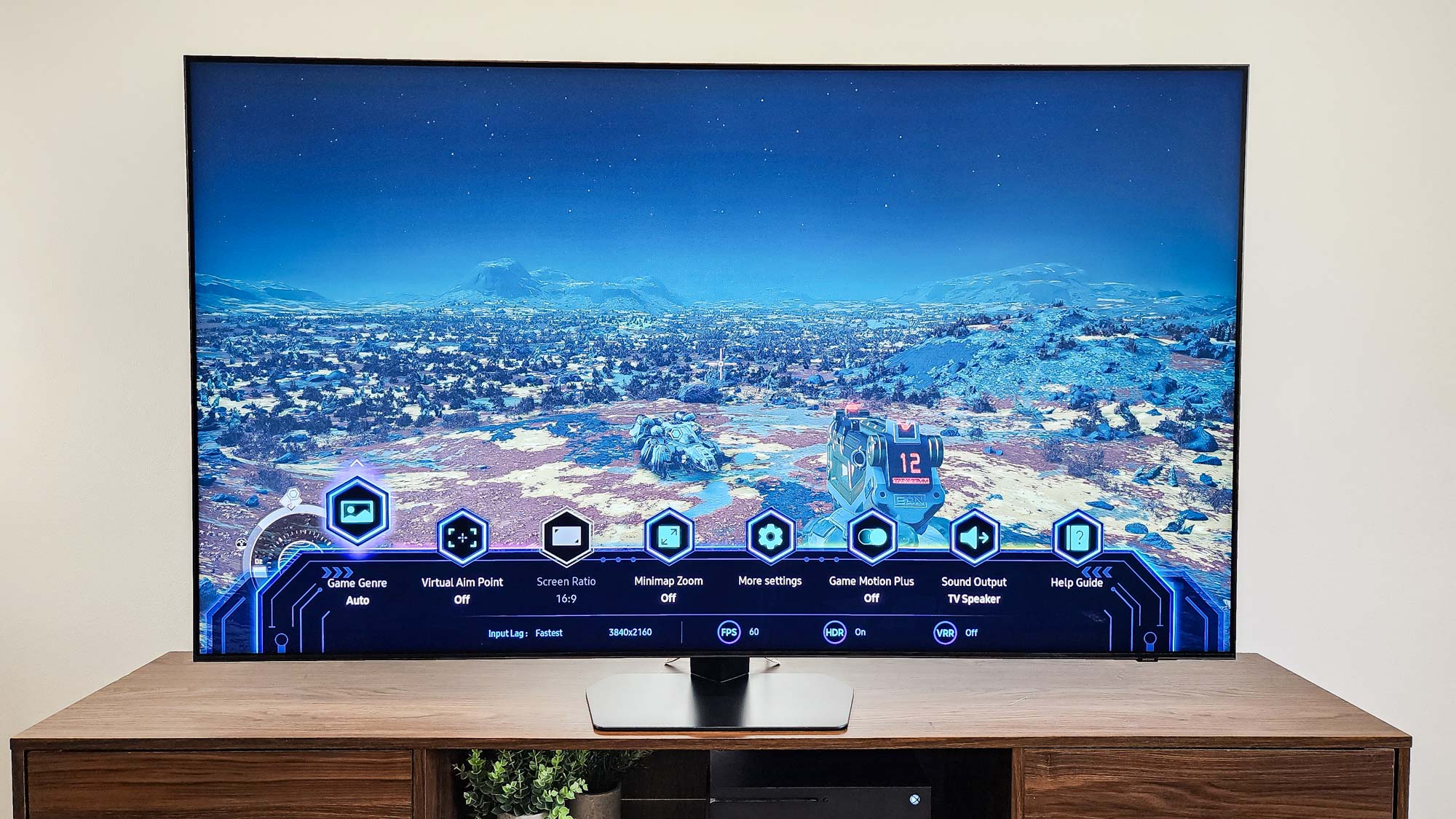
The QN90D’s input lag of 9.6ms, as measured with a Leo Bodnar 4K Signal Lag Tester, is excellent. It isn’t quite the lowest we’ve seen (other Samsung and LG TVs have gotten even closer to 9ms), but it’s more than enough to guarantee a near-ideal gaming experience. I verified this myself with a satisfying session of Starfield, where controls were responsive and action was smooth whether battling out in space or on the surface of planets in Bethesda’s sprawling sci-fi universe.
As mentioned previously, because all of the HDMI ports are capable of refresh rates up to 144Hz, connecting a PC with a higher-end graphics card will get you even silkier gameplay.
Samsung QN90D Neo QLED TV review: Smart features
Although Samsung still uses Tizen on its new TVs, the company has given it a much-needed refresh. It resembles the earlier versions both visually and in its ultra-laid-back aesthetic, but it’s more tightly designed and easier to navigate, with a clearer focus on the items you’re more likely to use, such as recent activity, popular searches, and apps being front and center.
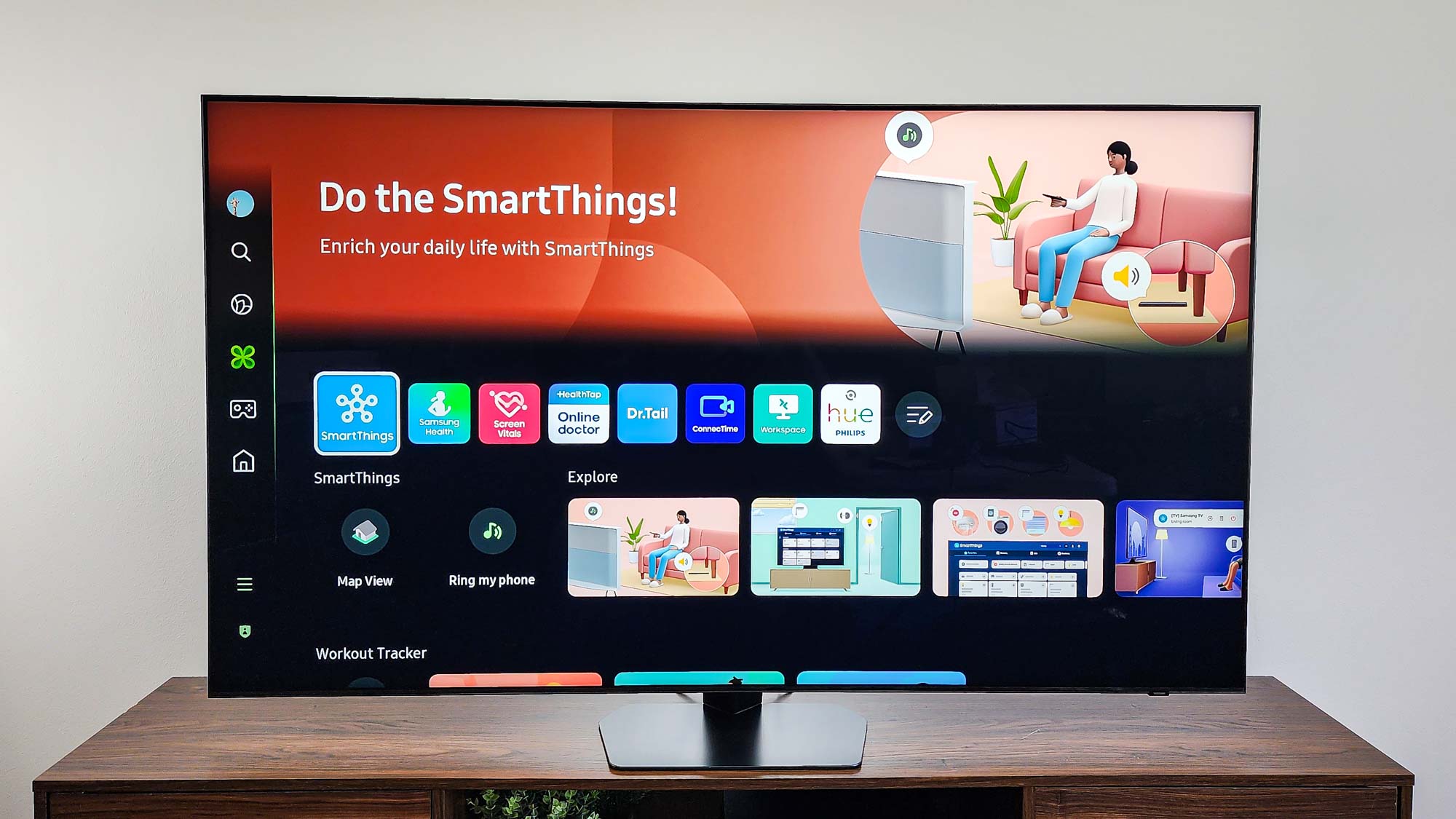
Some quirks persist (such as requiring the vertical menu bar on the left to do some essential tasks), and it never feels as polished or powerful as Google TV or LG’s webOS, but overall, the new Tizen is a substantial upgrade that significantly improves the TV’s usability.
In addition to using Search from the home screen, you can also speak commands into the remote control or use the TV’s far-field microphone. If you want to find something to watch over the air, however, you’re stuck with an integrated ATSC 1.0 tuner rather than the newer ATSC 3.0 tuner that allows viewing of 4K broadcasts. (This has been the subject of some controversy over the past year.) As with LG’s current-generation sets, this is an omission that is felt most keenly because of the TV’s higher price.
Samsung QN90D Neo QLED TV review: Remote
The QN90D uses the same SolarCell Remote that has been standard on Samsung TVs for the last couple of generations. The tiny solar panel on its back means you never have to worry about replacing batteries — just place it face-down in direct sunlight (or under electric lighting if you don’t mind a slower charge). You can even monitor the remote’s power level in the TV’s menus.

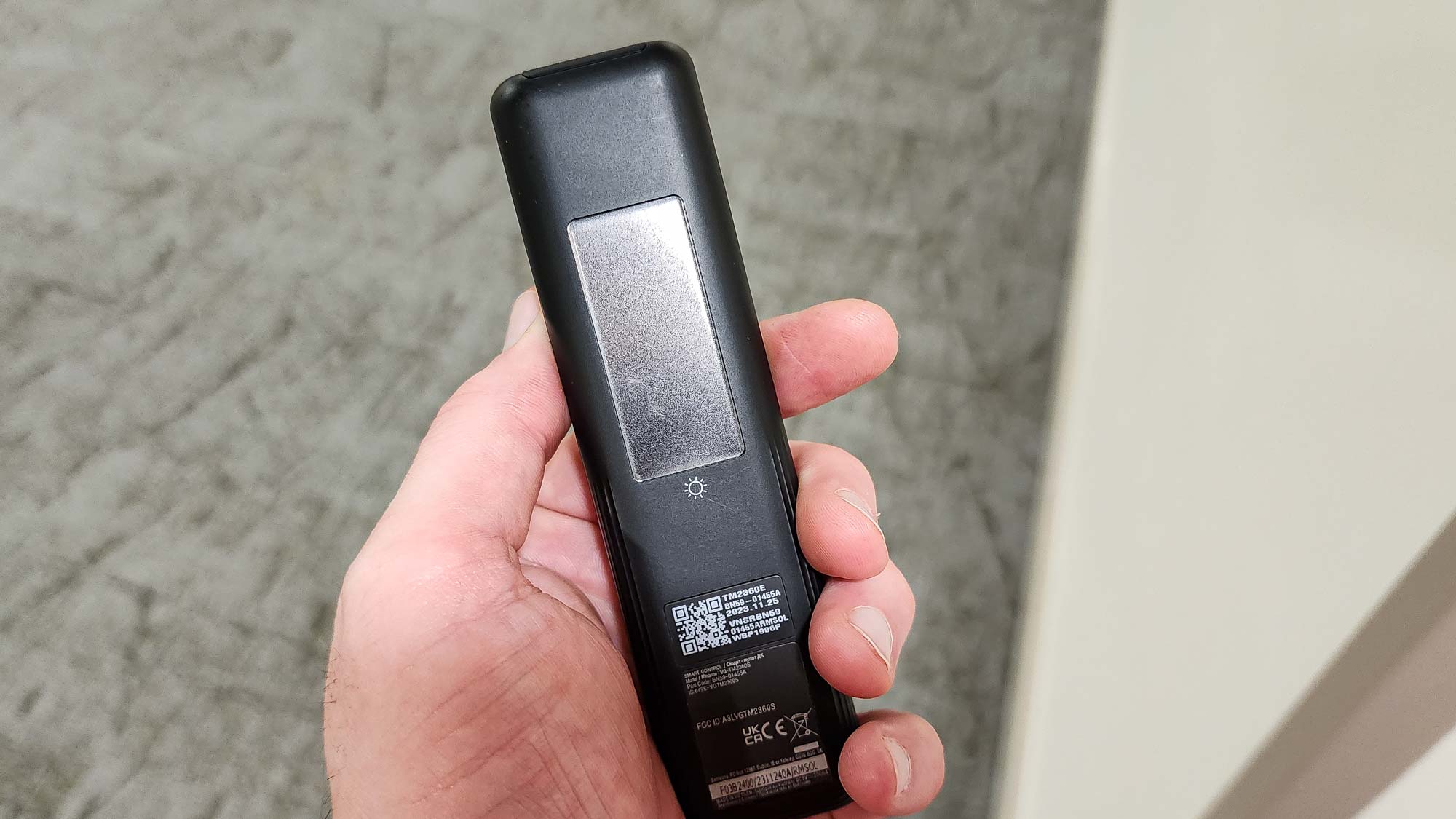
Otherwise, though, the remote is underwhelming, small in size and with a paltry number of buttons that either combine functions (such as Settings, numbers, and colors) or relegate to potentially confusing shortcuts a lot of basic functionality. The spare aesthetic isn’t bad as a concept, and keeping the number of buttons as low as possible is an admirable goal, but the remote remains a case of minimalism going just a bit too far.
Samsung QN90D Neo QLED TV review: Verdict
Samsung is all about the details, and there are plenty the QN90D Neo QLED TV gets right: Good picture quality and processing, fine gaming performance and features, even a revamped operating system — it all helps to make the QN90D feel like a complete package.
But the price is the major obstacle that amplifies the few minor obstacles. Though you can find the QN90D online for $2,500 or less, other sets like the Hisense U8N offer just as much — and in some cases, a bit more — for about half the price. If the QN90D were closer to perfect, the price would be more justified but issues like the skewed color accuracy, the lack of an ATSC 3.0 tuner, and that remote control prevent that from happening.
Of course, this is how we feel about the TV at its current launch price of $2,500. Once prices
fall later this generation and sales really amp up, this is a TV you’ll want to pay attention to. But right now the Samsung QN90D is a terrific TV that, unfortunately, isn’t currently a terrific value.







